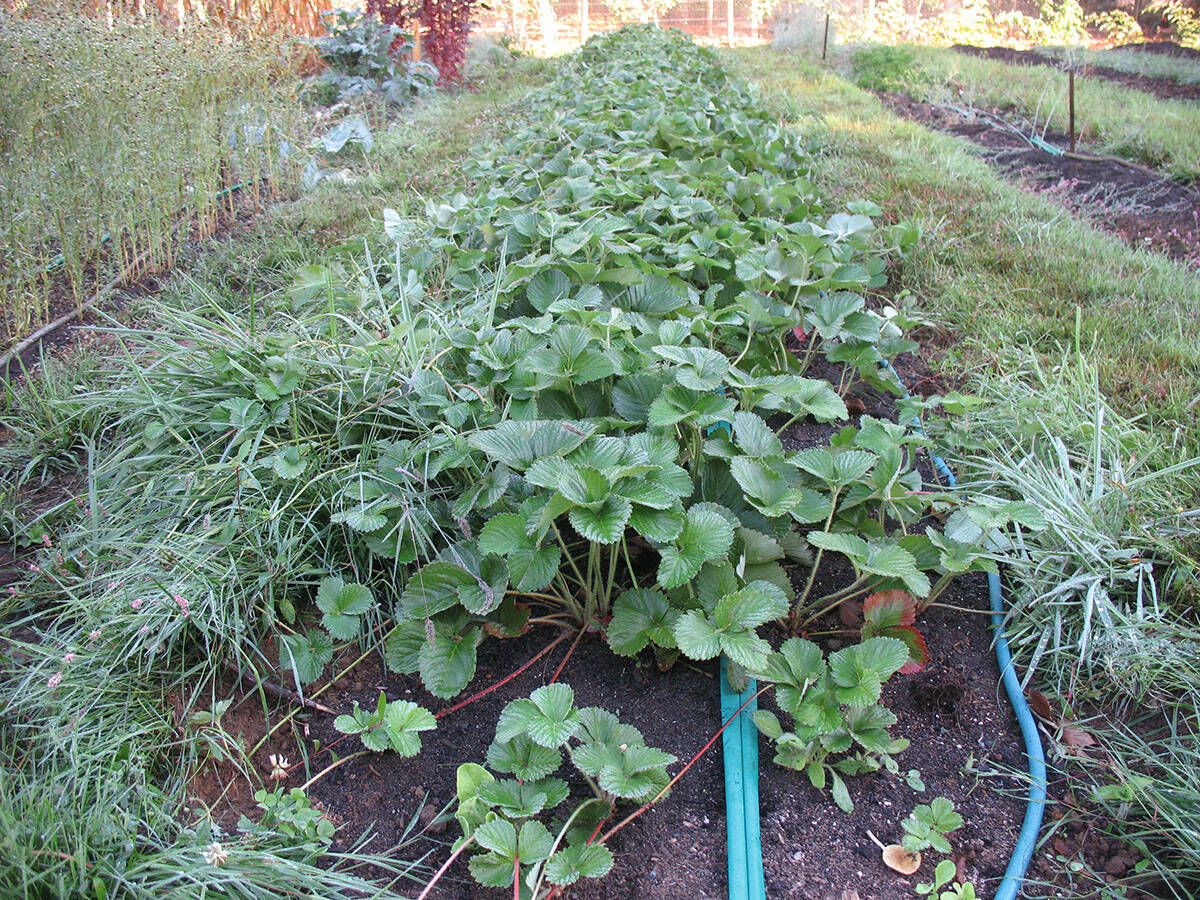By Mary Lowther
David insists that he was not born an obsessive, that it is a byproduct of decades working with surgical equipment. His mother, however, once told me that even as a child his books were filed under the Dewey Decimal System, so I suspect he had an inclination to a particular kind of retentiveness from an early age. For those readers who have never had to live with him, it takes some getting used to. For example, I have never known anybody else who hangs his picture frames with a laser level.
It follows that, when he decided to clear land and build me the larger garden I had been asking for, the beds were perfectly aligned and exactingly measured; when I needed strawberry cages to protect my crop from airborne predators they were perfectly formed works of art that exactly fit the beds, solid frames with half inch wire guaranteed to prevent even the most ravenous avian gourmand from reaching my crop, and immaculately symmetrical.
With such infrastructure to protect them my new strawberries prospered, flourishing joyfully in the full sun of summer as we expected a bumper crop. Every morning I enjoyed watching the lovely little birds, flitting around outside the strawberry cages as they hunted for their presumed meal of weed seeds and insect pests as the protected plants produced flowers that magically transformed into tiny berries, rapidly growing larger as they passed from green through white into the red that presages the harvest. My smile vanished when I discovered a brace of airborne little gluttons hopping about inside the cage with my strawberries vanishing into their happily chomping gullets!
Perhaps it was my shadow that warned them, or my involuntary howls of righteous indignation, but the airborne vandals immediately bolted for the holes they had burrowed under the frames. What few berries we could pry from their tightly clenched beaks were delicious, and went perfectly with a dinner of sparrow kebabs.
Further investigation revealed that their efforts had been aided by the growth of weeds under the frame itself, which created tiny gaps they could enlarge to burrow through. David, never one to accept final defeat, plans to install garden ties that exactly match the frames and can be clamped or bolted tightly together; I suspect the birds will spend their winters learning how to use their wings as shovels. The last couple of years have made me inclined to expect the worst. Predators in my garden seem determined to obey Darwin’s law of natural selection, evolving their way past every obstacle we invent for them.
Who can blame them? Often our instincts seek needed nutrients and tell by taste which foods are on their shopping list. David says kale must be the exception that proves the rule, but concedes that strawberries taste wonderful. It is not coincidental that they are jam packed with good stuff like potassium, folate, vitamin C, phytonutrients and fibre. Consequently, since I amended the soil with compost, Solomon’s complete fertilizer recipe with trace minerals and manure mix, we now have the tastiest and most nutritional birds in town.
We can buy June bearing or ever bearing strawberry plants. June bearing only produce fruit in the summer, usually in June as their name suggests. Ever bearing produce twice a year; in June and again in early fall. Blogger Benedict Vanheems recommends we remove all runners for the first three years to allow energy to go into growing the plant, then the fourth year we can let the runners go and pot up or transplant the seedlings. We can harvest berries for another two to three years, trimming off the runners each year and allowing them to grow out the following year. The first plants will have exhausted themselves by then and the new plants will take over the work. None of my manuals suggest nipping off the runners until the fourth year but I think Vanheems makes sense, so I will follow his advice.
I sure have a lot of runners. Perhaps I planted them too closely together, but I had no idea they’d grow so big. I’ll dig out the middle row and make a new bed with those plants. In the meantime I’ll prepare this bed for winter by trimming all the runners, digging out any dead plants and clearing the bed of weeds. I didn’t lay down any straw under the plants this year but if I had, I’d remove it all so those voracious bugs don’t make it their cozy spot to hibernate. Winter rains will surely wash out many nutrients so I’ll add more organic fertilizer next spring and keep my fingers crossed while David ransacks his Larousse in search of a recipe for deep fried finch.
Please contact mary_lowther@yahoo.ca with questions and suggestions since I need all the help I can get.

